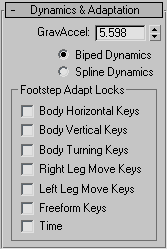The controls on the Dynamics & Adaptation rollout let you specify how to create biped animation. Here you can modify gravity strength, set dynamic properties for keys generated by newly created footsteps, determine the number of transform tracks available on the biped, and prevent key adaptation.
Biped Dynamics and Spline Dynamics
These parameters specify how character studio creates new biped center-of-mass keys, which determines how you work with the biped. Turning on Spline Dynamics will create center-of-mass keys without gravity or balance calculation for newly created footsteps. This may feel more familiar to the new user who is already familiar with spline interpolation.
Biped Dynamics calculates biped airborne trajectory, knee bend on landing and positions the biped to maintain balance when the spine is rotated. When parameters change, the biped adapts. Turn on Biped Dynamics and use this adaptation to your advantage.
You can change from one method to the other on a per-key basis or for the entire animation at any time.

When you change a footstep’s position or timing, Biped automatically adapts existing keyframes to match the new footsteps. The Adapt Locks settings let you preserve the positions and timing of existng keys for a selected track.
The adapt locks need not be on all the time. For example, if you want to raise all the footsteps along the world Z axis without
changing the upper-body position, turn on Footstep Adapt Locks group  Body Vertical Keys, access Footstep mode, select all the footsteps, and move them up along the world Z axis. The footsteps
are repositioned and the legs adapted, but the upper body retains the same motion rather than being raised with the footsteps.
Then turn off Body Vertical Keys, and the upper body still retains its original motion.
Body Vertical Keys, access Footstep mode, select all the footsteps, and move them up along the world Z axis. The footsteps
are repositioned and the legs adapted, but the upper body retains the same motion rather than being raised with the footsteps.
Then turn off Body Vertical Keys, and the upper body still retains its original motion.
Use Footstep Adapt Locks  Time to retain upper-body motion while editing footstep duration in Track View. When the duration of a footstep is changed,
the biped leg will adapt by retiming the touch, plant, and lift keys. The biped upper-body keys will retain their exact motion.
Time to retain upper-body motion while editing footstep duration in Track View. When the duration of a footstep is changed,
the biped leg will adapt by retiming the touch, plant, and lift keys. The biped upper-body keys will retain their exact motion.